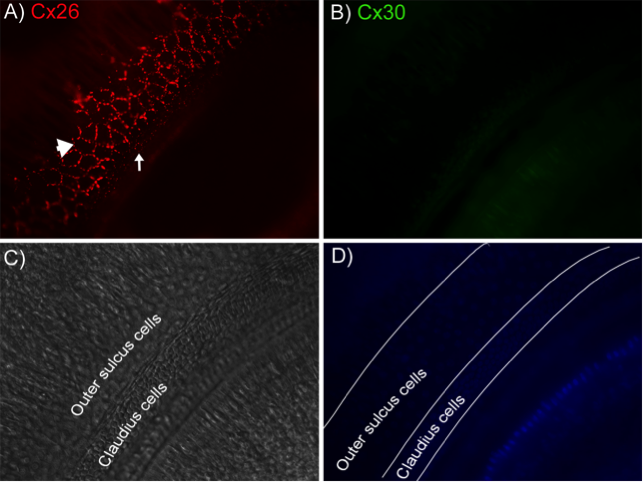This is a knockout-validated antibody summary, based on two publications "Tissue-specific cross-reactivity of connexin32 antibodies: problems and solutions unique to the central nervous system" [1] and "Gap junction mediated intercellular metabolite transfer in the cochlea is compromised in connexin30 null mice" [2]. Labome curates formal publications to compile a list of antibodies with unambiguous specificity within Validated Antibody Database (VAD).
Rabbit polyclonal
Company: Zymed
Antibody: Cx30
Catalog number: 71-2200
Summary: Rabbit polyclonal against a synthetic peptide derived from the unique C-terminus of the mouse Connexin 30. Reacts with human, mouse, rat, cat, chicken, and guinea pig. Suitable for western blot, immunofluorescence, immunohistochemistry, and ELISA.
Western blot
Brain and liver tissues from human and WT, and Cx30 knockout mice. All tissues were homogenized in fresh RIPA buffer (1% Nonidet P-40, 0.5% sodium deoxycholate, 0.1% SDS, 1 mM NaF, 50 g/ml aprotinin, 1 mM sodium orthovanadate, 1 mg/ml phenylmethylsulfonyl fluoride, 10 mM phosphate-buffered saline (PBS; 10 mM phosphate, 154 mM NaCl)).
5% (w/v) skim milk powder–PBS with 0.1% Tween-20 (PBST; blocking buffer) for 1 to 3 h.
1:200 dilution in blocking buffer overnight at 4°C.
Horseradish peroxidase (HRP)-conjugated anti-mouse (Jackson ImmunoResearch
Laboratories, PA; 1:2,000) diluted in blocking buffer for 1- to 3-h.
X-ray film using SuperSignal West Pico Chemiluminescent Substrate (Pierce, IL).
Please see Figure 8b in the article [1].
Immunohistochemistry

Cochlea of Cx30 null mice. Tissue was flattened and fixed in 4% paraformaldehyde.
10% goat serum (in PBS) for 1 hour.
1∶100 dilution overnight at 4°C.
FITC-conjugated (catalog# 111-096-003) goat anti rabbit secondary antibodies (Jackson ImmunoResearch Lab, West Grove, PA) for 2 hours at room temperature.
Conventional fluorescent microscope.
If the antibody described in this summary is a polyclonal antibody, since polyclonal antibodies are of limited quantity, please inquire the supplier whether any current polyclonal antibody with the same catalog number is exactly the same as the one described in this summary. Sometimes, different bleeds or different animals are used, usually with a different lot number. In such cases, the result in this summary may not apply to the new antibody with the same catalog number.
- If you are aware of any publication with knockout studies validating a monoclonal or recombinant antibody, either purchased from a supplier or developed by the author(s), please notify us through feedback.
- product
